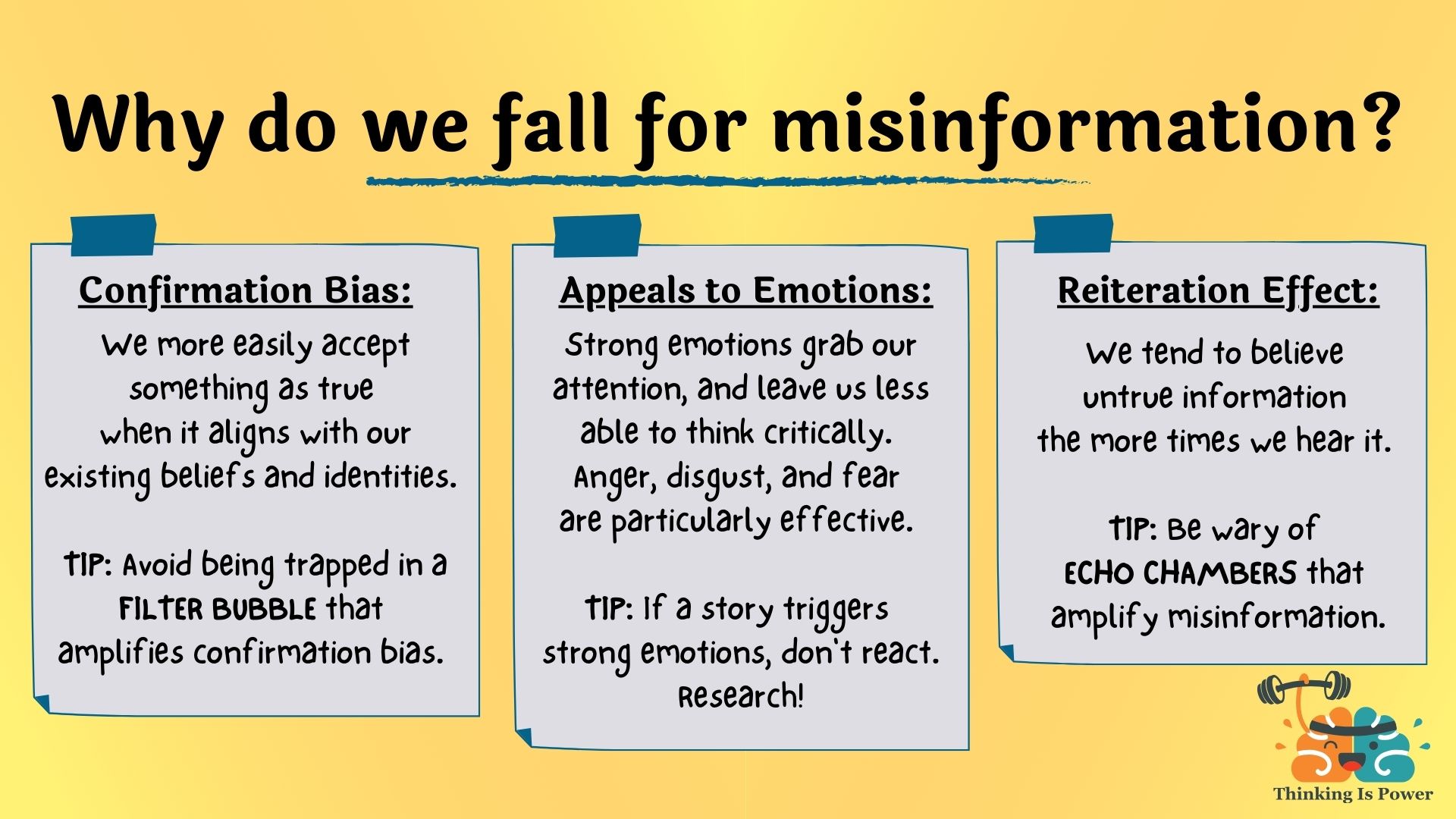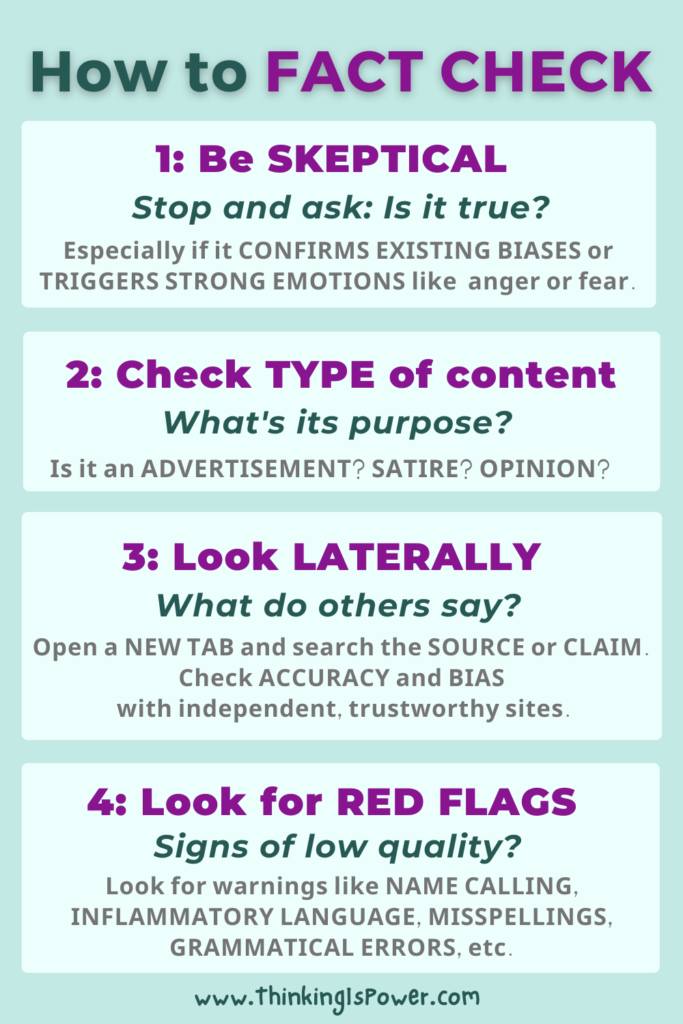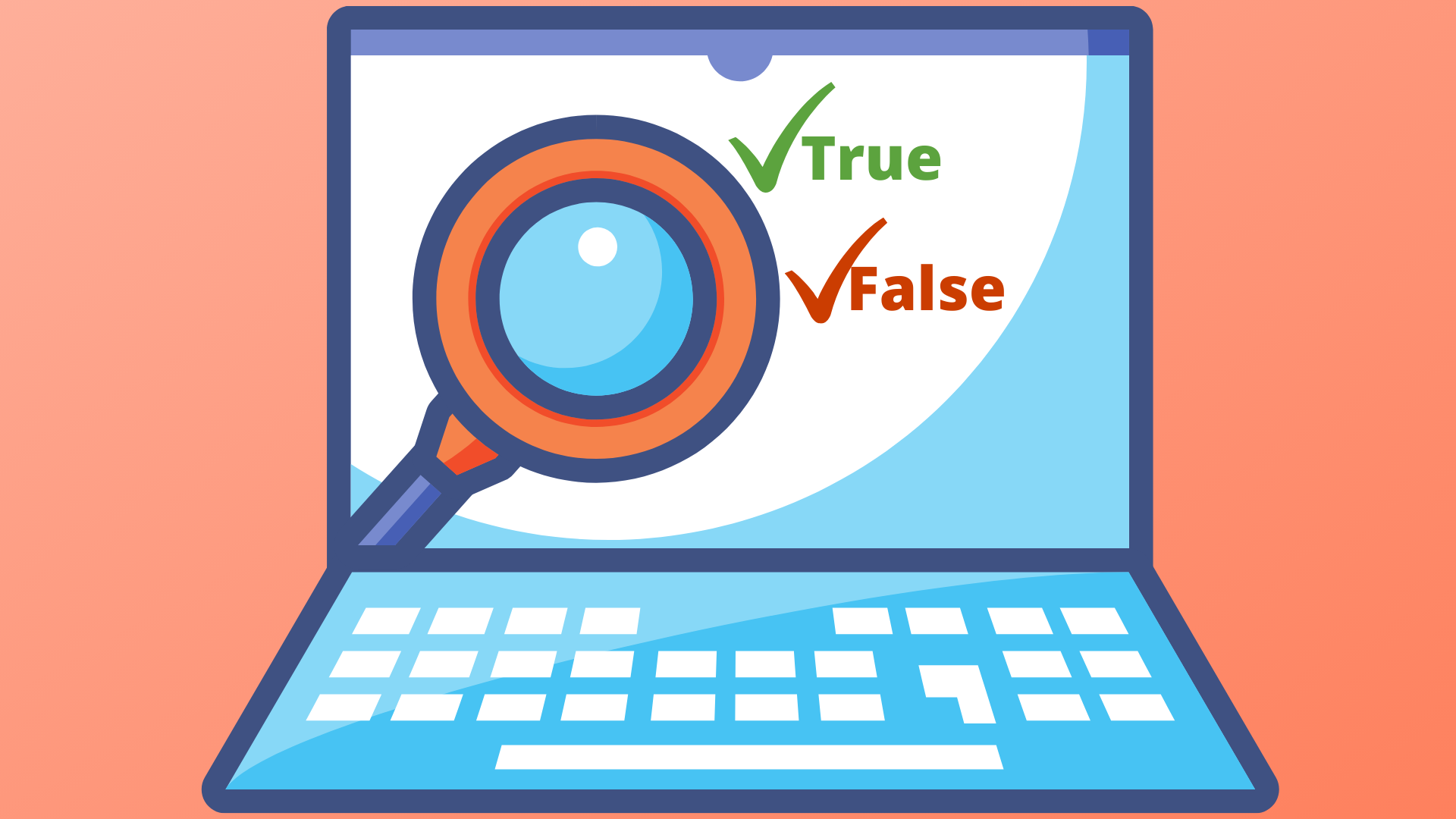Post truth. Alternative facts. Fake news. It’s enough to make anyone want to throw in the towel.
Information affects how we think and act. A good media diet allows us to make better decisions for ourselves and our families.
Unfortunately, there’s a lot of crap out there! Many simply decide we can’t believe anything “the media” says, or we retreat into a bubble where we only hear things that confirm what we already think is true.
And if you consider yourself an “independent thinker” who needs to “see things for themselves,” you’re likely to end up misled. There’s simply too much for any one person to know.
The reality is, knowledge is a community effort. You don’t think alone. Therefore an important part of knowing is knowing who to trust. Misplaced trust, or no trust, will lead you astray.
So, how are we to know what’s true, and who to trust? By learning how to fact check!
Fact-Checking 101
1. Be skeptical!
Skepticism, or proportioning our beliefs to the evidence, is always your first line of defense. Basically, before believing or sharing a post, stop and ask: is this true? But beware! The most difficult, and most important, time to be skeptical is when something:

a. Confirms what we already think is true. Confirmation bias is one of the biggest reasons we fall for misinformation. Our brains like to take short-cuts. So when we’re exposed to information, and need to decide whether or not we should believe it, our brains take a short-cut. Does it fit with what we already believe? Then it must be true! Don’t let your own biases be the reason you fall for fake news.
b. Triggers strong emotions. Appeals to emotions grab our attention, and make us more likely to engage with and share posts. Peddlers of disinformation know this, and use it against us. Anger, fear, disgust, and outrage are particularly effective, but so are positive emotions. We’re more beholden to our emotions than we realize, and when we’re emotionally triggered, we’re less able to think critically. So try to get into the habit of practicing emotional skepticism.
c. Is repeated. The more we’re exposed to information, the more likely we assume that it’s true… even if it’s not. This can be especially dangerous if we’re in an unreliable information ecosystem that echoes false claims repeatedly. Don’t let repetition be the reason you let down your guard!
2. What kind of content is it?
Not all content is intended to be factual and informative, so it’s important to understand the purpose of the post. Some possibilities include:
a. Advertisements: Most Americans are unaware of native ads, sponsored content, and advertorials that are designed to look like organic content. Look carefully for clues that someone is trying to sell you something, such as “sponsored,” “presented,” or “promotion.” (Learn more about online advertising.)
b. Satire: Does it sound outlandish? Satire uses humor, irony, or exaggeration to make a point, yet a surprising number of people aren’t aware it’s a joke. As always, it pays to be skeptical.
c. Opinion or analysis: While journalists clearly distinguish between news and opinion, the public can’t really tell a difference, and what many call “biased” or “fake” news is often opinion or analysis, not objective journalism. Unfortunately, many Americans think something is a “fact” when it agrees with their worldview and an “opinion” when it doesn’t. (That’s not what a fact is!)
Newspapers label opinion pieces in different ways, depending on the author:
- Opinions are written by the paper’s staff.
- Op-eds, or opposite the editorial page, are written by members of the community.
- Editorials are the position of the paper’s editorial board.
Cable news isn’t so transparent. For example, Fox News has a news side and an opinion side, but the audience is often unaware of the difference.
The point is, opinions aren’t facts. That being said, all opinions aren’t equal, and good opinion pieces are based on facts.
3. Look laterally: What do others say about the source or claim?
This simple trick separates the novices from the professionals. While many people have been taught to fact-check by going to a website’s “About” section, real fact-checkers know that if a website wants to deceive or mislead you they won’t put that in their “Mission Statement.” Lateral reading is faster and more reliable.
When evaluating a story, meme, video, etc., or using a search engine, look for who is behind the information. For example:
- Do you recognize the source, and are they reliable and trustworthy?
- What can you learn from the URL? Sites ending in .edu and .gov are generally reliable, while .com, .org, and .net are mixed.
- Does the site mimic or impersonate a well-known site? A common trick is to add or jumble letters, so it’s wise to look closely.
- No source? Danger! But claims are still fact-checkable.
a. Open a new tab, Google the site/person or claim, and see what other sources say. What do other (reliable) sources say? Is the source trustworthy? Is the claim true? What’s the evidence? The information ecosystem vets sources and claims, by building on what we know, correcting for errors, and disproving fraud and lies. If something is true, it will almost certainly be reported by multiple trustworthy organizations.
A note about searching: Make sure your search terms are neutral, because Google gives you what you ask. If you enter loaded or biased terms, your results will confirm your biases. And don’t necessarily trust that Google will put the most reliable sources at the top, or even on the first page.
b. Check accuracy with independent fact-checking sites. Websites like Snopes, Politifact, FactCheck, Reuters Fact Check, Rumor Guard, AP Fact Check, and The Washington Post Fact Checker all employ professional fact checkers. They’re rewarded for accuracy, and they show you their work, just in case you want to dive into the evidence yourself. Keep in mind that it might take a while for fact checkers to get to a new claim, and not all claims will be checked. But if one (or more!) of these sites has covered a story, trust that their detective work is generally reliable.
c. Check bias with independent sites. Everyone is biased….. including us! So it’s important to consider that the bias we see might actually be our own. A great way to be misled is to assume that news you don’t like is biased, and therefore you can disregard any of their reporting.
That being said, some sources are certainly more biased than others. Measuring bias is much more difficult than checking facts, because it’s subjective. Thankfully, a simple short-cut is to check with independent sites, such as All Sides, Ad Fontes, and Media Bias/Fact Check, that clearly communicate their methodology. And once again, general agreement among the sites indicates a more reliable conclusion.
4. Watch out for other red flags.

Low-quality, highly biased “news” often has a few other tells. For example:
a. They tell you not to trust anyone else: Trustworthy news organizations want to get it right, so they’re not afraid of others checking their work. Truth withstands scrutiny. So be especially wary of any news site telling you that they’re the only source of truth and/or everyone else is lying to you.
b. Inflammatory language, name-calling, and YELLING: An easy way to get more eyes, clicks, and shares is to use loaded and inflammatory language that elicits strong emotions, often in combination with digital SHOUTING. Name-calling and insults work well, too, as do appealing to tribalism and an “us vs them” worldview. Remember to practice emotional skepticism!
c. Misspellings or grammatical errors: Unsurprisingly, many fake news websites lack good editors and quality control.
d. Misleading headlines: Nearly 60% of people share articles without reading past the headline. (Don’t do that!) Low quality articles often have click-bait or inaccurate headlines that don’t match the story. It also pays to check the links in the story. Inactive links are a warning sign.
e. Lots of pop-up and banner ads: Be wary of sites loaded with ads, as they are probably more interested in making a quick buck than in high-quality, unbiased reporting. Uncoincidentally, they make more money the more clicks they get, and thus often resort to the various tricks discussed so far.
5. Advanced tips: Check images and video.
a. Images: Ever heard that a picture is worth a thousand words? Images are convincing and easily sharable… the perfect storm, especially since it’s incredibly easy to alter images these days. The solution is to learn how to reverse image search. (It’s not as hard as it sounds!)
b. Videos: Misleading videos are a growing problem, again due to the human tendency to think we can believe what we see. You may have heard of deep fakes, but unfortunately the problem is much larger, as videos can be missing context or deceptively edited. Thankfully, The Washington Post has a helpful guide to manipulated video.
The take-home message
Learning to fact check is an important step towards media literacy. However, real empowerment will require a systemic approach. Our media diets inform us about our world, so consider using your fact-checking skills to cleanse your news feed of junk. Limit your news consumption to the organizations that have a reliable track-record of accurate and less biased coverage, and break out of echo chambers that repeat false or misleading stories. You’ll find yourself less outraged and more informed.
To Learn More:
News Literacy Project: Understanding Bias
FactCheck.org: How to spot fake news
Scholastic Choices: How to fact-check the internet
American Press Institute: What Americans know, and don’t, about how journalism works
Ben Peters: 30 tips on using media from a media scholar
Thanks to Lynnie Bruce and Liz Strzepa for their feedback.

Pingback: Thinking is Power: Don’t be fooled… fact check! | Climate Change
Pingback: Thinking is Power: Don't be fooled... fact chec...
Pingback: Who is Susceptible to Misinformation? – Library Hangout
Great info! Thank you.
Thanks for the comment!
Melanie
You’re wrong about trusting the
“independent fact checkers”, they were designed for an agenda, NOT the truth. Don’t trust google either, though you mention “google” at least twice, instead of just saying “search”.
Yep, you’re biased, but at least you tried.
My bias is to help people find reliable information. Independent fact checkers show their work, and are part of an international organization of professionals who are held to high standards.(See: https://www.poynter.org/ifcn/)
There’s a reason disinformation and propaganda sites tell their consumers not trust reliable sources of information. Don’t allow them to lead you astray.
Thanks for the comment.
Melanie
Bud, Bud, Bud,
Fact checkers are paid to be objective. So there is no need for an agenda. Try checking a few new “facts” that you heard from a Fox News evening broadcast. If the fact checkers claim your facts to be inaccurate, then look to another news source that you deem credible to see if your facts are being reported there. Use any search engine that you wish.